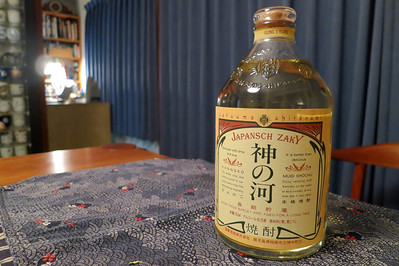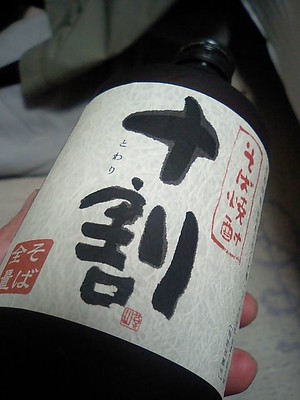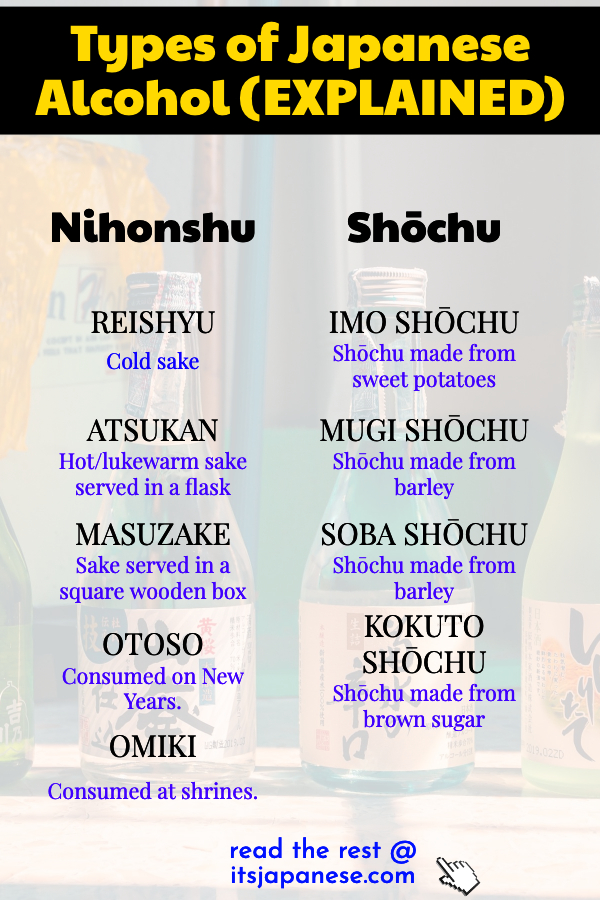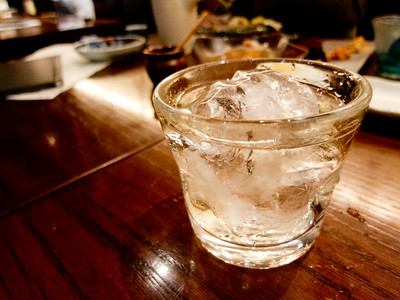What are the types of Japanese alcohol?
Well, if you read articles here and there… they’ll give you common beers, whiskeys, and whatnot…
But if we’re talking about Japanese alcohol…
As in, native-made-in-Japan-only kind of alcohol…
Then there are 2 major types: Nihonshu and Shōchu. And don’t worry, these 2 types of Japanese alcohol are all explained all below.
Types of Japanese Alcohol: Nihonshu
Starting off with Nihonshu / Sake, the various examples that will be provided are all essentially of the same nature. What sets them apart is the ‘8-tier’ grading system that is used to describe the quality of each drink. Nihonshu / Sake (terms used interchangeably) refer to drinks that are made of rice, shirokōji, and water, which contain approximately 10-12% of alcohol. Sake can be enjoyed cold, hot, and lukewarm. According to Japanese Mythology, the original purpose of Sake was to be used as an offering to God.
Let’s look at a few examples!
1. REISHYU (冷酒・お冷や)
As briefly mentioned earlier, Sake can be enjoyed in various temperatures. Reishu/Ohiya is an example of a cold Sake. It is usually served in a small glass – generally a glass that holds 80ml, but there are bigger sizes that would go up to 120ml – this should provide a visual of how small one serving is!
2. ATSUKAN (熱燗)
Atsukan is a type of Sake that is enjoyed in lukewarm to hot temperatures.
This Sake is poured into a flask known as Tokkuri, that is heated up in a hot water bath. This ‘bath’ is created by filling about two-thirds of a pot with water, placing the Tokkuri (flash containing Atsukan) in the pot, and heating it up on the stove. This water is left to heat up, and just before reaching boiling point – i.e. 80℃ – the fire will be switched off. The Tokkuri is to be left for approximately 2 to 3 minutes, bringing the Sake to around 40-45℃. Depending on whether the individual would prefer a warmer (50℃) drink or a cooler (35℃) drink, the Tokkuri can be left longer or shorter. Knowing the exact preferred temperature is a trait of an experienced Atsukan drinker!
3. MASUZAKE (枡酒)
Masuzake is a rather interesting one to experience in Japanese pubs, known as Izakaya.
Let’s break down the name first. ‘Masu’ was originally a square-shaped wooden box used to measure rice in Japan. In this wooden box, a glass to hold the Sake is placed. This completes the phrase, ‘Masuzake’ – ‘Masu’ for the wooden box holding the Sake (Zake).
The glass is filled to the brim, as far as surface tension will allow. It is common for the Masuzake to overflow into the Masu as well. To begin with Masuzake, you would slowly lift the glass and slightly tilt it to allow some of the sake to be poured into the Masu. This prevents spillage while taking the first sip from the glass. Having finished the Masuzake in the glass, you can proceed to pour the excess Sake from the Masu back into your glass, or alternatively you can choose to drink directly from the Masu.
In the instances that the Masu is made of Hinoki, or Japanese cypress, you can enjoy the fragrance of the Hinoki alongside the fragrance of the Sake, creating a multi-sensory experience. With that, you will have experienced your first Masuzake drink!
4. OTOSO (お屠蘇)
These next two drinks (Otoso and Omiki) are special to Japanese culture. Otoso is a Sake that is only consumed on the first few days of the New Year. Traditionally, families share this drink as a prayer to welcome in the New Year. By having Otoso, Japanese believe that it brings good luck, while avoiding any negative accidents.

5. OMIKI(御神酒)
Another special drink to Japanese culture is Omiki. This Sake is only consumed at shrines, on special occasions such as the New Year, wedding ceremonies, and so on. Omiki can be carried out in a few ways. One way is for Japanese people themselves to offer Sake as ‘Omiki’ to the shrine. For those who have personal altars at home, they can carry out this ceremony in their own home. Another way is for the shrine to offer Omiki to people who visit the shrine – this is usually what occurs on special occasions.
Types of Japanese Alcohol – Shōchu
Next up, le’ts explore Shōchu.
In comparison to Sake, Shōchu is rather ‘new’ in that it has only been around for the past 500-600 years. Shōchu is classified as a spirit, and thus is produced through distillation. The alcoholic content ranges from 25-40%, and is usually enjoyed ‘on the rocks’ with ice, mixed with water, or mixed with a carbonated drink. The composition of the Shōchu varies, and as you will see, the names are a direct reflection of the main ingredient. Let’s get into it!
1. IMO SHŌCHU (芋焼酎)
Imo Shōchu is Shōchu made from sweet potatoes, which is called ‘Imo’ in Japanese. It is usually the Shōchu of choice. Since there is a lot of variety when it comes to potatoes, the taste of the Shōchu would consequently vary depending on the type of potato. Which is why even within the Imo Shōchu category, you may find distinguishing characteristics of each drink. It is said to have a great depth of richness in flavor, despite the different types of potatoes that may be used.

2. MUGI SHŌCHU
Mugi refers to ‘barley’ in Japanese, and thus this Shōchu is made of barley! It is characterised as ‘easy to drink’. This is due to its’ fruity fragrance, paired with its’ gentle and light flavour. Mugi Shōchu is said to be the most economical choice, making it a rather friendly option to try.

3. SOBA SHŌCHU
You may be wondering, soba? The noodles? You’re right! ‘Soba’ is Japanese for buckwheat. Which is why this Shōchu, made from buckwheat, is called Soba Shōchu! The brewery and production of Soba Shōchu is much more limited in comparison to Imo and Mugi Shōchu. You will also realise that there are much less brands available in the market, reflecting that it is more specific to a region. It is said to have the weakest sense of after-taste, with a very slight fragrance of buckwheat.

4. KOKUTO SHŌCHU
Finally, Kokuto means ‘brown sugar’, so this Shōchu is called Kokuto Shōchu. Within Japan, Kokuto can only be produced in the southern islands. There are only 27 Kokuto Shōchu breweries in Japan, located in the Amami Islands. Since Kokuto Shōchu is of an Alkaline nature, it is said that the individuals from the Amami Islands who regularly drink Kokuto Shōchu live longer lives!
Back to You
Now you know a bit about the types of Japanese alcohol. Mainly, Nihonshu and Shōchu.
Which have you tried?
Which are your favorites?
Leave a comment. We read ’em all.
– Team IJ





